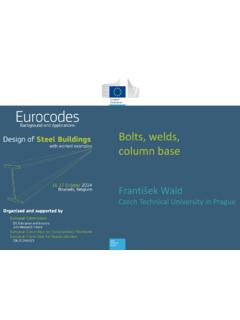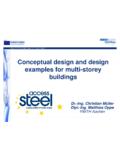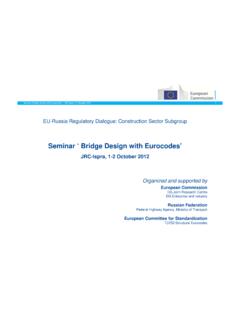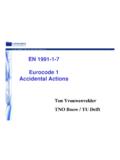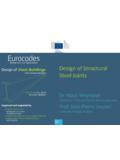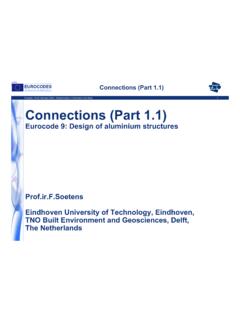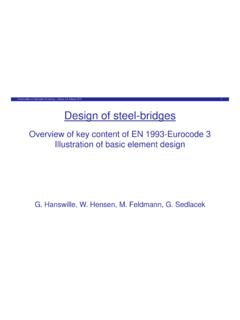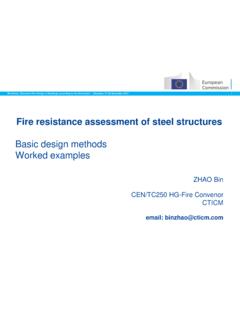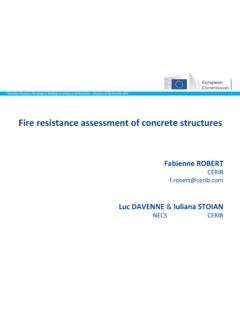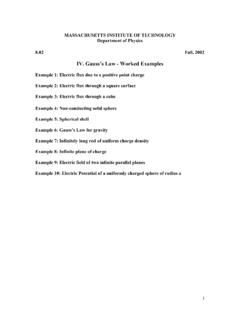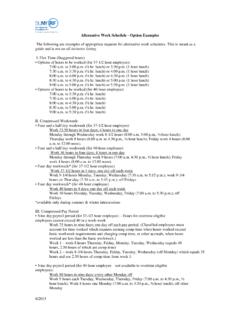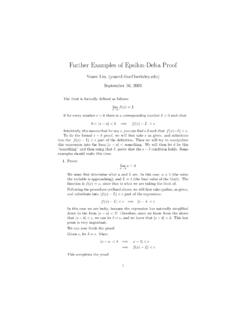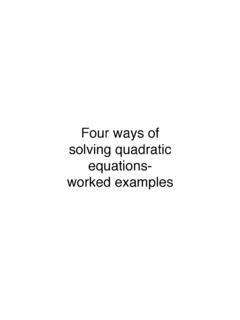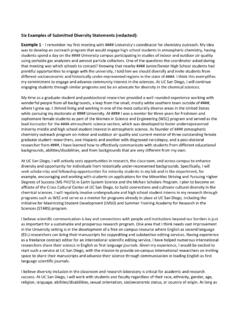Transcription of Bridge Design to Eurocodes Worked examples
1 EUR 25193 EN - 2012 Bridge Design to Eurocodes Worked examples Worked examples presented at the Workshop Bridge Design to Eurocodes , Vienna, 4-6 October 2010 Support to the implementation, harmonization and further development of the Eurocodes Y. Bouassida, E. Bouchon, P. Crespo, P. Croce, L. Davaine, S. Denton, M. Feldmann, R. Frank, G. Hanswille, W. Hensen, B. Kolias, N. Malakatas, G. Mancini, M. Ortega, J. Raoul, G. Sedlacek, G. Tsionis Editors A. Athanasopoulou, M. Poljansek, A. Pinto G. Tsionis, S. Denton The mission of the JRC is to provide customer-driven scientific and technical support for the conception, development, implementation and monitoring of EU policies. As a service of the European Commission, the JRC functions as a reference centre of science and technology for the Union.
2 Close to the policy-making process, it serves the common interest of the Member States, while being independent of special interests, whether private or national. European Commission Joint Research Centre Contact information Address: JRC, ELSA Unit, TP 480, I-21027, Ispra (VA), Italy E- mail: Tel.: +39-0332-789989 Fax: +39-0332-789049 Legal Notice Neither the European Commission nor any person acting on behalf of the Commission is responsible for the use which might be made of this publication. Europe Direct is a service to help you find answers to your questions about the European Union Fr eephone number (*): 00 800 6 7 8 9 10 11 (*) Certain mobile telephone operators do not allow access to 00 800 numbers or these calls may be billed. A great deal of additional information on the European Union is available on the Internet.
3 It can be accessed through the Europa server JRC 68415 EUR 25193 EN ISBN 978-92-79-22823-0 ISSN 1831-9424 doi: Luxembourg: Publications Office of the European Union, 2012 European Union, 2012 Reproduction is authorised provided the source is acknowledged Printed in Italy i Acknowledgements The work presented in this report is a deliverable within the framework of the Administrative Arrangement under the Memorandum of Understanding between the Directorate-General for Enterprise and Industry of the European Commission (DG ENTR) and the Joint Research Centre (JRC) on the support to the implementation, harmonisation and further development of the Eurocodes . ii iii Table of Contents Acknowledgements i Table of contents iii List of authors and editors xi Foreword xi ii Introduction xv Chapter 1 Introduction to the Design example Introduction 3 Geometry of the deck 3 LONGITUDINAL ELEVATION 3 TRANSVERSE CROSS-SECTION 3 ALTERNATIVE DECKS 4 Geometry of the substructure 5 PIERS 5 ABUTMENTS 7 BEARINGS 7 Design specifications 8 Design WORKING LIFE 8 NON-STRUCTURAL ELEMENTS 8 TRAFFIC DATA 9 ENVIRONMENTAL CONDITIONS 10 SOIL CONDITIONS 11 SEISMIC DATA 11 OTHER SPECIFICATIONS 11 Materials 11 Details on structural steel and slab reinforcement 12 STRUCTURAL STEEL DISTRIBUTION 12 DESCRIPTION OF THE SLAB REINFORCEMENT 15 iv Construction process 16 LAUNCHING OF THE STEEL GIRDERS 16 SLAB CONCRETING 16 Chapter 2 Basis of
4 Design (EN 1990) Introduction 21 EN 1990 Section 1 General 21 EN 1990 Section 2 - Requirements 21 EN 1990 Section 3 Principles of limit state Design 22 Design SITUATIONS 22 ULTIMATE LIMIT STATES 23 SERVICEABILITY LIMIT STATES 23 EN 1990 Section 4 Basic variables 24 ACTIONS 24 MATERIAL AND PRODUCTS PROPERTIES 25 EN 1990 Section 5 Structural analysis and Design assisted by testing 26 EN 1990 Section 6 Limit states Design and Annex A2 Application for bridges 26 Design VALUES 26 ULTIMATE LIMIT STATES 27 SINGLE SOURCE PRINCIPLE 27 SPECIAL CASES IN THE APPLICATION OF EQU 28 COMBINATIONS OF ACTIONS 29 LIMIT STATE VERIFICATIONS 31 Conclusions 32 Summary of key concepts 33 CHAPTER 3 Actions on Bridge deck and piers (EN 1991) Part A: Wind and thermal action on Bridge deck and piers Introduction 37 Brief description of the procedure 37 v Wind actions on the deck 40 Bridge DECK DURING ITS SERVICE LIFE, WITHOUT TRAFFIC 40 Bridge DURING ITS SERVICE LIFE, WITH TRAFFIC 43 Bridge UNDER CONSTRUCTION (MOST CRITICAL CASE ABD TERMINATION OF PUSHING) 43 VERTICAL WIND FORCES ON THE Bridge DECK (Z-DIRECTION) 45 WIND FORCES ALONG THE Bridge DECK (Y-DIRECTION) 46 Wind actions on the piers 46 SQUAT RECTANGULAR PIER 46 HIGH CIRCULAR CYLINDRICAL PIER 47 Thermal actions 48 Part B.
5 Action during execution, accidental actions and traffic loads Introduction 50 Actions during execution 50 LAUNCHING PHASE 52 Accidental actions 55 IMPACT OF VEHICLES ON THE Bridge SUBSTRUCTURE 56 IMPACT OF VEHICLES ON THE Bridge SUPERSTRUCTURE 56 Traffic loads 57 STATIC LOAD MODELS 58 GROUPS OF TRAFFIC LOADS ON ROAD BRIDGES 60 LOAD COMBINATIONS FOR THE CASE STUDY 61 FATIGUE LOAD MODELS 65 FATIGUE ASSESSMENT OF THE COMPOSITE Bridge 67 CHAPTER 4 Bridge deck modelling and structural analysis Introduction 79 Shear lag effect 79 GLOBAL ANALYSIS 79 SECTION ANALYSIS 80 vi Concrete creep effect (modular ratios) 81 SHORT TERM MODULA RATIO 81 LONG TERM MODULAR RATIO 81 Elastic mechanical properties of the cross sections 83 UN-CRACKED COMPOSITE BEHAVIOR 83 CKRACKED COMPOSITE BEHAVIOR 84 Actions modelling 85 SELF-WEIGHT 85 NON-STRUCTURAL EQUIPMENTS 85 CONCRETE SHRINKAGE IN THE COMPOSITE DECK 86 ROAD TRAFFIC 87 Global analysis 90 Main results 91 VERTICAL SUPPORT REACTIONS 92 INTERNAL FORCES AND MOMENTS 92 STRESSES AT ULS 92 CHAPTER 5 93 Concrete Bridge Design (EN 1992-2) Introduction 97 Local verifications in the concrete slab 97 DURABILITY CPVER TO REINFORCEMENT 97 TRANSVERSE REINFORCEMENT VERIFICATIONS 99 LONGITUDINAL REINFORCEMENT VERIFICATIONS 116 PUNCHING SHEAR (ULS)
6 118 Second order effects in the high piers 121 MAIN FEATURES OF THE FORCES AND MOMENTS ON TOP OF THE PIERS 121 FORCES AND MOMENTS ON TOP OF THE PIERS 122 SECOND ORDER EFFECTS 122 vii CHAPTER 6 Composite Bridge Design (EN 1994-2) Verification of cross-section at mid-span P1-P2 127 GEOMETRY AND STRESSES 127 DETERMINING THE CROSS-SECTION CLASS (ACCORDING TO EN1994-2, ) 127 PLASTIC SECTION ANALYSIS 130 Verification of cross-section at internal support P1 132 GEOMETRY AND STRESSES 132 DETERMINING THE CROSS-SECTION CLASS (ACCORDING TO EN1994-2, ) 132 SECTION ANALYSIS 134 Alternative double composite cross-section at internal support P-1 139 DETERMINING THE CROSS-SECTION CLASS (ACCORDING TO EN1994-2, ) 142 PLASTIC SECTION ANALYSIS. BENDING AND RESISTANCE CHECK 144 SOME COMMENTS ABOUT EVENTUAL CRUSHING OF THE EXTREME FIBRE OF THE BOTTOM CONCRETE 144 Verification of the Serviceability Limit Sates (SLS) 145 Stresses control at Serviceability Limit States 145 CONTROL OF COMPRESSIVE STRESS IN CONCRETE 145 CONTROL OF STRESS IN REINFORCEMENTSTEEL BARS 146 STRESS LIMITATION IN STRUCTURAL STEEL 147 ADDITIONAL VERIFICATION OF FATIGUE UDER A LOW NUMBER OF CYCLES 150 LIMITATION OF WEB BREATHING 151 Control of cracking for longitudinal global bending 151 MAXIMUM VALUE OF CRACK WIDTH 151 CRACKING OF CONCRETE.
7 MINIMUM REINFORCEMENT AREA 152 CONTROL OF CRACKING UNDER DIRECT LOADING 153 CONTROL OF CRACKING UNDER INDIRECT LOADING 155 Shear connection at steel-concrete interface 156 RESISTANCE OF HEADED STUDS 156 DETAILING OF SHEAR CONNECTION 157 viii CONNECTION Design FOR THE CHARACTERISTIC SLS COMBINATION OF ACTIONS 160 CONNECTION Design FOR THE ULS COMBINATION OF ACTIONS OTHER THAN FATIGUE 163 SYNOPSIS OF THE Design example 165 Design OF THE SHEAR CONNECTION FOR THE FATIGUE ULS COMBINATION OF ACTIONS 166 INFLUENCE OF SHRINKAGE AND THERMAL ACTION ON THE CONNECTION Design AT BOTH DECK ENDS 171 CHAPTER 7 Geotechnical aspects of Bridge Design (EN 1997) Introduction 177 Geotechnical data 177 Ultimate limit states 183 SUPPORT REACTIONS 183 GENERAL: THE 3 Design APPROACHES OF EUROCODE 7 185 Abutment C0 189 BEARING CAPACITY (ULS) 189 SLIDING (ULS) 192 Pier P1 (Squat Pier) 193 BEARING CAPACITY (ULS) 193 SETTLEMENT (SLS) 195 Seismic Design situations 196 CHAPTER 8 Overview of seismic issues for Bridge Design (EN 1998-1, EN 1998-2)
8 Introduction 201 example of ductile pier 201 Bridge CONFIGURATION Design CONCEPT 201 SEISMIC STRUCTURAL SYSTEM 203 FUNDAMENTAL MODE ANALYSIS IN THE LONGITUDINAL DIRECTION 205 MULTIMODE RESPONSE ANALYSIS 206 Design ACTION EFFECTS AND VERIFICATION 209 BEARINGS AND ROADWAY JOINTS 219 ix CONCLUSION FOR Design CONCEPT 224 example of limited ductile piers 224 Bridge CONFIGURATION Design CONCEPT 224 Design SEISMIC ACTION 225 SEISIC ANALYSIS 226 VERIFICATIONS OF PIERS 237 BEARINGS AND JOINTS 239 example of seismic isolation 241 Bridge CONFIGURATION Design CONCEPT 241 Design FOR HORIZONTAL NON-SEISMIC ACTIONS 247 Design SEISMI ACTION 249 SEISMIC STRUCTURAL SYSTEM 253 FUNDAMENTAL MODE METHOD 257 NON-LINERTIME HISTORY ANALYSIS 262 VERIFICATION OF THE ISOLATION SYSTEM 269 VERIFICATION OF SUBSTRUCTURE 271 Design ACTION EFFECTS FOR THE FOUNDATION 278 COMPARISON WITH FUNDAMENTAL MODE METHOD 279 APPENDICES 283 APPENDIX A A-1 Design of steel bridges.
9 Overview of key contents of EN 1993. APPENDIX B B-1 A sample analytical method for bearing resistance calculation APPENDIX C C-1 examples of a method to calculate settlements for spread foundations APPENDIX D D-1 Generation of semi-artificial accelerograms for time-history analysis through modification of natural records x xi List of authors and editors Authors Introduction Steve Denton, Parsons Brinckerhoff, Chairman of CEN/TC250 Horizontal Group Bridges Georgios Tsionis, University of Patras, Secretary of CEN/TC250 Horizontal Group Bridges Chapter 1 Introduction to the Design example Pilar Crespo, Ministry of Public Works (Spain) Laurence Davaine, French Railway Bridge Engineering Department (SNCF, IGOA) Chapter 2 Basis of Design (EN 1990) Steve Denton, Parsons Brinckerhoff, Chairman of CEN/TC250 Horizontal Group Bridges Chapter 3 Actions on Bridge decks and piers (EN 1991) Nikolaos Malakatas, Ministry of Infrastructures, Transports and Networks (Greece) Pietro Croce, Department of Civil Engineering, University of Pisa, Italy Chapter 4 Bridge deck modeling and Design Laurence Davaine, French Railway Bridge Engineering Department (SNCF, IGOA) Chapter 5 Concrete Bridge Design (EN 1992) Emmanuel Bouchon, Large Bridge Division, Setra/CTOA, Paris, France Giuseppe Mancini, Politecnico di Torino, Italy Chapter 6 Composite Bridge Design (EN 1994-2)
10 Miguel Ortega Cornejo, IDEAM , University Europea de Madrid , Spain Joel Raoul, Large Bridge Division, Setra/CTOA, Ecole Nationale de Ponts et Chausses, Paris, France Chapter 7 Geotechnical aspects of Bridge Design (EN 1997) Roger Frank, University Paris-Est, Ecole den Ponts ParisTech, Navier-CERMES Yosra Bouassida, University Paris-Est, Ecole den Ponts ParisTech, Navier-CERMES Chapter 8 Overview of seismic issues for Bridge Design (EN 1998-1, EN 1998-2) Basil Kolias, DENCO , Athens Appendix A Design of steel bridges. Overview of key content of EN 1993. Gerhard Hanswille, Bergische Universitat Wolfang Hensen, PSP - Consulting Engineers xii Markus Feldmann, RWTH Aachen University Gerhard Sedlacek, RWTH Aachen University Editors Adamantia Athanasopoulou, Martin Poljansek, Artur Pinto European Laboratory for Structural Assessment Institute for the Protection and Security of the Citizen Joint Research Centre, European Commission Georgios Tsionis, Steve Denton CEN/TC250 Horizontal Group Bridges xiii Foreword The construction sector is of strategic importance to the EU as it delivers the buildings and infrastructure needed by the rest of the economy and society.

